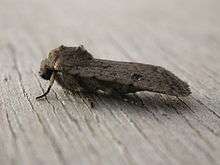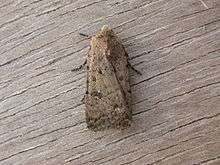Paradrina clavipalpis
Paradrina clavipalpis, the pale mottled willow, is a moth of the family Noctuidae. The species was first described by Giovanni Antonio Scopoli in his 1763 Entomologia Carniolica. It is found in the Palearctic ecozone (Europe, Algeria, Morocco, Tunisia, Libya, Egypt, Kuwait, Russia, Central Asia, Mongolia, Iraq, Iran, Afghanistan, Pakistan, north-west India and Sri Lanka). It is an introduced species in North America, where it was first reported from Queens in New York City in 1993. In 2009 it was found in Rochester, New York, so it appears to be established and spreading.
_clavipalpis01.jpg)
| Paradrina clavipalpis | |
|---|---|
 | |
 | |
| Scientific classification | |
| Kingdom: | Animalia |
| Phylum: | Arthropoda |
| Class: | Insecta |
| Order: | Lepidoptera |
| Superfamily: | Noctuoidea |
| Family: | Noctuidae |
| Genus: | Paradrina |
| Species: | P. clavipalpis |
| Binomial name | |
| Paradrina clavipalpis | |
| Synonyms | |
| |
Description
The wingspan is 26–35 mm. The length of the forewings is 12–15 mm. Forewing pale to dark grey with darker dusting and sometimes tinged with ochreous; the terminal area generally fuscous; the lines starting from black costal spots; the inner and outer double, blackish, the inner minutely waved, the outer dentate; subterminal line pale, waved, preceded by a grey shade with dentate rufous marks in it; stigmata small, fuscous, the orbicular rounded, the reniform a narrow lunule, with two white dots on its inner edge and three on outer; hindwing white, the veins and termen dark grey; — in laciniosa Donz. the subterminal line consists of a row of three yellowish spots each extended to termen; — the form leucoptera Thnbg., from Scandinavia, Finland, and the Ural Mountains, has fuscous suffusion over the head, thorax, and forewing, the hindwing remaining white.[1][2]
Biology
The moth flies from April to October depending on the location. There are two generations per year in North America.
Larva fuscous with a green tinge; the lines paler, with dark edges. The larvae feed on Plantago and various grasses.[3]
Taxonomy
Some authors consider the genus Paradrina to be a subgenus of Caradrina, hence the species is also known as Caradrina clavipalpis or Caradrina (Paradrina) clavipalpis.
References
- Seitz, A. Ed., 1914 Die Großschmetterlinge der Erde, Verlag Alfred Kernen, Stuttgart Band 3: Abt. 1, Die Großschmetterlinge des palaearktischen Faunengebietes, Die palaearktischen eulenartigen Nachtfalter, 1914
- Hampson, G. F. (1894). The Fauna of British India, Including Ceylon and Burma: Moths Volume II. Taylor and Francis – via Biodiversity Heritage Library.
- "Robinson, G. S., P. R. Ackery, I. J. Kitching, G. W. Beccaloni & L. M. Hernández, 2010. HOSTS - A Database of the World's Lepidopteran Hostplants. Natural History Museum, London".
External links
| Wikimedia Commons has media related to Caradrina clavipalpis. |
- Pale mottled willow on UKMoths
- Fauna Europaea
- Savela, Markku. "Caradrina clavipalpis (Scopoli, 1763)". Lepidoptera and Some Other Life Forms. Retrieved January 22, 2019.
- Lepiforum e.V.
- De Vlinderstichting (in Dutch)